Elections from 1924 to 1964
This section contains information and memorabilia on the elections from 1924 to 1964. Scroll down the page to learn more about specific election years.
Election of 1924
Vice President Calvin Coolidge became president after the sudden death of Warren Harding in 1923. Shortly after, reports of government scandals were revealed. Investigations had discovered that members of the Harding administration had received bribes to lease oil reserves on government property in Teapot Dome, Wyoming, to private oil men. Coolidge was not implicated; his reputation for integrity and honesty remained intact. He easily won the Republican nomination at the 1924 convention. The Democratic Party was split into two powerful factions. The southern and western wing supported Woodrow Wilson’s son-in-law and treasury secretary, William Mc Adoo of California. This faction was influenced by the newly re-emerging Ku Klux Klan and was anti-immigration and for prohibition. Meanwhile, the northern and eastern faction of the party was influenced by the big city political machines and was strongly pro-immigration and against prohibition. Their candidate, Catholic New York governor Al Smith, was unacceptable to the southern Democrats. The result was a contentious national convention. It required 103 ballots and lasted 17 days before a compromise candidate,  Congressman and former Wall Street lawyer John W. Davis, was nominated. The Progressive Party reemerged as a coalition of farmers, laborers, and socialists to nominate Republican Senator Robert LaFollette of Wisconsin on a corporate reform platform.
Congressman and former Wall Street lawyer John W. Davis, was nominated. The Progressive Party reemerged as a coalition of farmers, laborers, and socialists to nominate Republican Senator Robert LaFollette of Wisconsin on a corporate reform platform.
Coolidge did little actual campaigning, while Davis toured the country criticizing Coolidge’s silence and the scandals of the previous administration. “Silent Cal” was a man of few words. “I am for economy” and “the business of America is business” were his basic non-controversial themes. In the end, Coolidge’s popularity, combined with the split in the Democratic Party and the general prosperity in the country, made him hard to defeat. The election resulted in another Republican landslide. Coolidge received 382 electoral votes to 136 for Davis and 13 for LaFollette. The popular vote was 54 percent Republican, 30 percent Democrat, and 16.6 percent Progressive. Virginia cast its 12 electoral votes for John Davis.
Election of 1928
Despite his continued popularity and the countries general prosperity, President Calvin Coolidge refused to run for another term. The Republican Party instead turned to Herbert Hoover, a former engineer, self-made millionaire, and secretary of commerce. Hoover was popular with his party for his humanitarian relief efforts during and after World War I. There was essentially no opposition; Hoover was nominated on the first ballot with a platform to continue the Coolidge policies and uphold the 18th Amendment (Prohibition). Because William McAdoo refused to run, New York governor Al Smith had no serious competition for the Democratic nomination. The southern faction of the Democratic Party still viewed Smith as a liability because of his Catholicism and his anti-prohibition views. To appease the southern wing of the party, which supported prohibition, Arkansas senator Joseph Robinson was picked to be Smith’s running mate.
The Hoover campaign emphasized the country’s prosperity. The Republicans promised a “chicken in every pot and two cars in every garage.” Both sides also used the radio for campaigning, although Smith was hurt nationally by his regional New York accent and his occasionally poor grammar. Considering that there were so many factors against him, Smith did remarkably well, especially in large cities and urban areas. The final electoral vote was 444 for Hoover (with 58.2 percent of the popular vote) against 44 electoral votes for Smith (with 40.8 percent popular vote). Virginia cast its 12 electoral votes for Herbert Hoover.
Election of 1932
The stock market crash and subsequent depression began only eight months after President Herbert Hoover’s inauguration in 1929. His attempts to improve the economy proved unsuccessful. By the time of the 1932 presidential election, there was widespread unemployment because of business and farm failures. In some cities, the unemployed only had the shelter of run 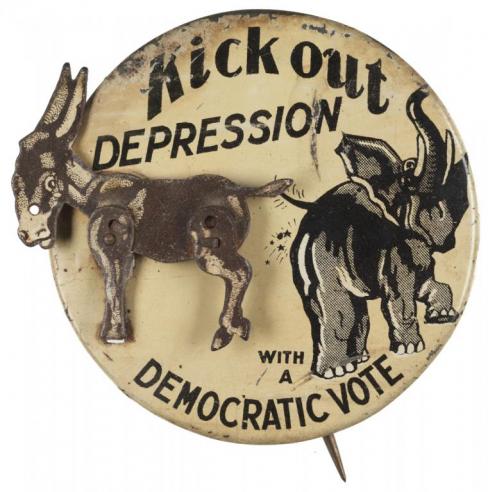 down shacks; these areas were nicknamed “Hoovervilles.” Hoover’s once positive image as a humanitarian and successful administrator had vanished. Nonetheless, in the absence of any other viable candidate and hopeful of reversing the economic failures, the Republican Party nominated Hoover on the first ballot of its convention. The Democrats sensed the opportunity to recapture the White House. Although Al Smith and several others sought the nomination, former vice presidential candidate and New York governor Franklin Delano Roosevelt was nominated on the fourth ballot of the Democratic convention. Roosevelt became the first candidate to give an acceptance speech at a national convention; he called for a “New Deal” on behalf of the American people.
down shacks; these areas were nicknamed “Hoovervilles.” Hoover’s once positive image as a humanitarian and successful administrator had vanished. Nonetheless, in the absence of any other viable candidate and hopeful of reversing the economic failures, the Republican Party nominated Hoover on the first ballot of its convention. The Democrats sensed the opportunity to recapture the White House. Although Al Smith and several others sought the nomination, former vice presidential candidate and New York governor Franklin Delano Roosevelt was nominated on the fourth ballot of the Democratic convention. Roosevelt became the first candidate to give an acceptance speech at a national convention; he called for a “New Deal” on behalf of the American people.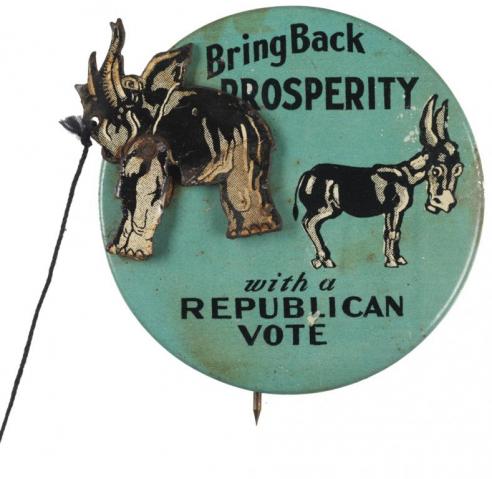
Both parties made extensive use of the radio during the campaign. Still, in part to demonstrate his strength and vitality despite having crippling polio, Roosevelt did an extensive speaking tour of the country. Concern over the economy and Hoover’s apparent inability to solve the crisis led to a landslide victory for Roosevelt (472 electoral votes to 59). Americans were hopeful that a new administration could find a solution to the depression. Virginia cast its 11 electoral votes for Franklin Roosevelt.
Election of 1936
By 1936, President Franklin D. Roosevelt’s “New Deal” plan to combat the economic crisis had resulted in substantial improvement; the country was hopeful for a full recovery. However, the Great Depression had not  ended. Unemployment remained high and the national debt was increasing. With a Democratic Party platform to expand the New Deal, Roosevelt was easily nominated for a second term. The Republicans chose Alf Landon, a conservative governor of Kansas who had balanced his state’s budget but who had also been a “Bull Moose” progressive. The Republican Party platform, although agreeing with some New Deal programs, attacked the unbalanced budget and “wasteful” spending. Anti–New Deal followers of recently deceased Louisiana governor Huey Long and popular Catholic priest Father Charles Coughlin backed a candidate, William Lemke, of the Union Party. Labor had received favorable legislation with New Deal programs and as a result, began to play a role in Democratic politics. For the first time, organized labor endorsed a candidate when the new Congress of Industrial Organizations (CIO), led by United Mine Workers president John L. Lewis, formed a political action group called Labors Non-Partisan League.
ended. Unemployment remained high and the national debt was increasing. With a Democratic Party platform to expand the New Deal, Roosevelt was easily nominated for a second term. The Republicans chose Alf Landon, a conservative governor of Kansas who had balanced his state’s budget but who had also been a “Bull Moose” progressive. The Republican Party platform, although agreeing with some New Deal programs, attacked the unbalanced budget and “wasteful” spending. Anti–New Deal followers of recently deceased Louisiana governor Huey Long and popular Catholic priest Father Charles Coughlin backed a candidate, William Lemke, of the Union Party. Labor had received favorable legislation with New Deal programs and as a result, began to play a role in Democratic politics. For the first time, organized labor endorsed a candidate when the new Congress of Industrial Organizations (CIO), led by United Mine Workers president John L. Lewis, formed a political action group called Labors Non-Partisan League.
Campaign strategies in 1936 included the extensive use of radio. President Roosevelt continued his “fireside” chats. Republicans complained that this gave the president an unfair advantage and requested their own free airtime. Campaigns also began to make use of advertising professionals and public opinion polls. With big business supporting the Republicans, and labor supporting the Democrats, both parties had considerable funds. The result of the election was an overwhelming victory for Roosevelt and the Democratic Party. Roosevelt won more than 60 percent of the popular vote and an electoral vote margin of 523 to 8. Landon only won the states of Maine and Vermont. Democrats also controlled the Senate and House of Representatives by wide margins. The Democratic constituency now included labor unions, industrial workers, farmers, unemployed, liberals, southern whites, the elderly (especially with the passage of the Social Security Act), and for the first time, black Americans. Virginia cast its 11
electoral votes for Franklin Roosevelt.
 Election of 1940
Election of 1940
Although unemployment remained high and economic recovery had not been achieved, the major issue of the 1940 election was the war in Europe. The Republican Party nominated Wendell Willkie, a former Wall Street lawyer and utilities company president. As an articulate, charismatic, nonpolitical former businessperson, he had become a favorite of a professional community that was tired of the New Deal. Although Franklin D. Roosevelt did not outwardly seek a nomination for a third term, his close associates were aware that he would accept the candidacy if drafted by the convention. Roosevelt easily won the nomination on the first ballot and reluctantly chose Henry Wallace as his running mate.
Willkie went on an extensive speaking tour of the country and attacked Roosevelt’s third-term bid and failures of his New Deal policies while promoting America’s neutrality concerning the war in Europe. Though Roosevelt did not personally campaign until just before the election, his supporters attacked Willkie. Before the election, Willkie warned that a Roosevelt victory would result in America’s involvement in the war. In a final speech, Roosevelt claimed “Your boys are not going to be sent to any foreign wars.” Although his margin of victory was less than it had been in 1936, Franklin Roosevelt was elected for an unprecedented third time. He received 54 percent of the popular vote. Roosevelt’s electoral victory was 449 to Willkie’s 82. Virginia cast its 11 electoral votes for Franklin Roosevelt.
Election of 1944
With America at war, President Franklin D. Roosevelt actively sought the nomination for an unprecedented fourth term. There were no other viable Democratic candidates to replace the commander in chief, and therefore he was selected on the first ballot. Concerned about Roosevelt’s failing health, most Democratic Party leaders argued to replace ultra-liberal Henry Wallace as the vice presidential candidate. Missouri senator Harry S. Truman was chosen as Wallace’s  replacement. The Republicans nominated New York governor and former racket-busting district attorney Thomas Dewey for president. He immediately declared that any negative campaigning about the conduct of the war would be unpatriotic. Dewey’s campaign instead focused on attacking Roosevelt’s age and health, as well as promoting fuller employment by working with private enterprise. Dewey campaigned actively with speaking tours and extensive use of radio speeches. In contrast, Roosevelt refused to campaign until shortly before the election when, concerned that his lack of campaign appearances would give credence to the belief that his health was failing, he gave a series of speeches that energized the Democratic campaign. Once again, the CIO and organized labor supported Roosevelt.
replacement. The Republicans nominated New York governor and former racket-busting district attorney Thomas Dewey for president. He immediately declared that any negative campaigning about the conduct of the war would be unpatriotic. Dewey’s campaign instead focused on attacking Roosevelt’s age and health, as well as promoting fuller employment by working with private enterprise. Dewey campaigned actively with speaking tours and extensive use of radio speeches. In contrast, Roosevelt refused to campaign until shortly before the election when, concerned that his lack of campaign appearances would give credence to the belief that his health was failing, he gave a series of speeches that energized the Democratic campaign. Once again, the CIO and organized labor supported Roosevelt.
The outcome of the election was similar to the 1940 result. Roosevelt received 53.4 percent of the popular vote and 432 electoral votes to 99 for Dewey. Most likely, the war was the deciding factor in the campaign. Most Americans did not wish to change leadership while the events of the war in 1944 appeared to indicate a successful conclusion. Following his inauguration in January, Roosevelt suffered a fatal cerebral hemorrhage in April 1945 and was succeeded by Truman. The war ended five months later. Virginia cast its 11 electoral votes for Franklin Roosevelt.
Election of 1948
President Harry S. Truman’s initial postwar popularity soon eroded because of developing economic problems that included inflation, rising prices, higher taxes, and labor strikes. Following victories in the 1946 Congressional elections, the Republican Party was optimistic that it would recapture the White House in 1948. Among the contenders for the Republican presidential nomination were Robert Taft, Harold Stassen, and Gen. Douglas McArthur. In the first televised political national convention, however, the GOP again nominated Thomas Dewey. The Democrats, sensing defeat, tried to draft the popular Gen. Dwight D. Eisenhower. When Eisenhower refused to run, the party again turned to Truman. Following the adoption of a strong civil rights platform by the Democratic convention, delegates from Alabama and Mississippi walked out, and several days later formed the States Rights or “Dixiecrat” Party. Its presidential nominee was South Carolina governor Strom Thurmond. In addition, left-wing Democrats and other liberal groups, dissatisfied with Truman’s post war policies with Russia, formed a new Progressive Party. It nominated the man Roosevelt had replaced with Truman in 1944, former Vice President Henry Wallace.
Republican presidential nomination were Robert Taft, Harold Stassen, and Gen. Douglas McArthur. In the first televised political national convention, however, the GOP again nominated Thomas Dewey. The Democrats, sensing defeat, tried to draft the popular Gen. Dwight D. Eisenhower. When Eisenhower refused to run, the party again turned to Truman. Following the adoption of a strong civil rights platform by the Democratic convention, delegates from Alabama and Mississippi walked out, and several days later formed the States Rights or “Dixiecrat” Party. Its presidential nominee was South Carolina governor Strom Thurmond. In addition, left-wing Democrats and other liberal groups, dissatisfied with Truman’s post war policies with Russia, formed a new Progressive Party. It nominated the man Roosevelt had replaced with Truman in 1944, former Vice President Henry Wallace.
 During the campaign, Truman, promising to “give ’em hell,” went on an extensive “whistle stop” train tour of the country. Rather than attacking Dewey, Truman criticized the Republican Congress as the “no account, do nothing, Eightieth Congress.” Despite the increasing size of the crowds at Truman’s speeches as the election neared, polls continued to show Dewey in the lead. Anticipating a victory, the headline in the Chicago Tribune the morning after the election read “Dewey Defeats Truman.” But in a remarkable upset, Truman captured 303 electoral votes to 189 for Dewey and more than 2 million more popular votes. The States Rights Party received 39 electoral votes, while the Progressive Party received none. Virginia cast its 11 electoral votes for Harry Truman.
During the campaign, Truman, promising to “give ’em hell,” went on an extensive “whistle stop” train tour of the country. Rather than attacking Dewey, Truman criticized the Republican Congress as the “no account, do nothing, Eightieth Congress.” Despite the increasing size of the crowds at Truman’s speeches as the election neared, polls continued to show Dewey in the lead. Anticipating a victory, the headline in the Chicago Tribune the morning after the election read “Dewey Defeats Truman.” But in a remarkable upset, Truman captured 303 electoral votes to 189 for Dewey and more than 2 million more popular votes. The States Rights Party received 39 electoral votes, while the Progressive Party received none. Virginia cast its 11 electoral votes for Harry Truman.
Election of 1952
The Truman administration suffered a loss in popularity from an unpopular Korean War, the spread of communism in China, and bribery scandals in government. Consequently, when Harry Truman refused to run again, the Democrat Party nominated Adlai Stevenson, the scholarly governor of Illinois and grandson of Grover Cleveland’s vice president, as its candidate. Although both the Democratic and Republican parties had previously been interested in Dwight D. Eisenhower as their candidate, by 1952 he had declared himself a Republican and was easily nominated at their convention. The Republican Party campaign intended to attack Democrats with a strategy called the “K1C2” formula (Korea, communism, corruption). Junior senator Richard M. Nixon, who had been active in anticommunist investigations, was nominated for the vice presidency.
candidate. Although both the Democratic and Republican parties had previously been interested in Dwight D. Eisenhower as their candidate, by 1952 he had declared himself a Republican and was easily nominated at their convention. The Republican Party campaign intended to attack Democrats with a strategy called the “K1C2” formula (Korea, communism, corruption). Junior senator Richard M. Nixon, who had been active in anticommunist investigations, was nominated for the vice presidency.
The Eisenhower campaign was carefully planned with advice from advertising experts. A telephone campaign and numerous television commercials were designed to reach voters in their homes. Additionally, Eisenhower traveled by plane, giving speeches in forty-four states. Republicans also actively sought the women’s vote with T.V. commercials based on family values. The Democrat’s slogan was “you never had it so good,” but the campaign lacked the planning and strategy of the Republicans. Stevenson also traveled the country by plane, giving intelligent and witty speeches, but projected poorly on television. The Eisenhower campaign received a serious blow when a newspaper article accused Nixon of receiving and personally using a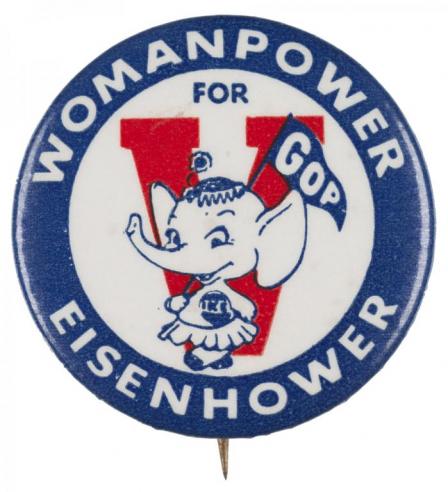 secret fund of political money. Nixon defended himself to a nationwide television audience claiming the money was used entirely for political purposes. He added that the only gift he received was a dog named Checkers that his children loved and he was going to keep. Following the “Checkers speech, ” the Republican National Committee received a deluge of positive mail supporting Nixon. Eisenhower agreed to keep him on the ticket.
secret fund of political money. Nixon defended himself to a nationwide television audience claiming the money was used entirely for political purposes. He added that the only gift he received was a dog named Checkers that his children loved and he was going to keep. Following the “Checkers speech, ” the Republican National Committee received a deluge of positive mail supporting Nixon. Eisenhower agreed to keep him on the ticket.
Near the end of the campaign, Eisenhower announced that if elected, he would “go to Korea” to end the war. This pledge, along with his popularity as a military hero, led to a landslide victory. Along with 55 percent of the popular vote, Dwight Eisenhower received 442 electoral votes to 89 for Stevenson. Virginia cast its 12 electoral votes for Dwight D. Eisenhower.
 Election of 1956
Election of 1956
The popular Dwight D. Eisenhower was easily nominated at the Republican convention in 1956. The country was at peace after the Korean War and enjoying economic prosperity. The only question was Eisenhower’s health following a heart attack he suffered in 1955, but his recuperation had been uneventful, and he was anxious to run for a second term. After some initial hesitancy, the controversial Richard Nixon was again nominated for vice president. The Democrats turned once again to Adlai Stevenson, who had defeated Tennessee governor Estes Kefauver in the party primaries. Despite some early support for young Massachusetts senator John F. Kennedy, Kefauver was chosen as Stevenson’s running mate. Though Eisenhower did less traveling and active campaigning than in 1952, extensive use of television commercials promoted the Republican theme of “peace, progress, and prosperity.” Stevenson traveled extensively by plane, giving speeches at rallies across the country. 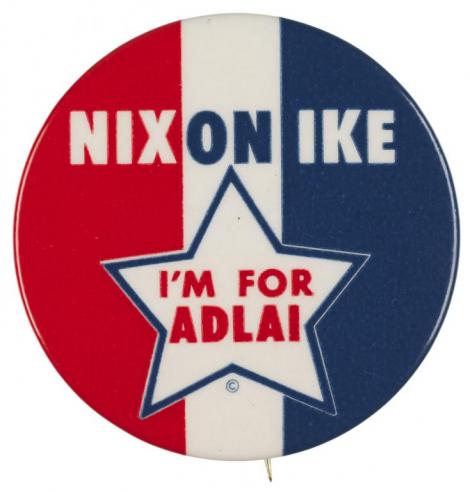
Democrats tried to use Eisenhower’s health, age, and the possibility of Richard Nixon replacing him as issues. Just before the election, the Soviet Union invaded Hungary, and British forces invaded Egypt over the rights to the Suez Canal. The voters trusted Eisenhower, with his military and international background, as the better candidate to handle this crisis. The president’s popularity combined with Stevenson’s divorce (at a time when Republicans were promoting family values), led to an overwhelming Eisenhower victory. Along with 57 percent of the popular vote, Eisenhower received 457 electoral votes to 73 for Stevenson. Virginia cast its 12 electoral votes for Dwight D. Eisenhower.
Election of 1960
With the 22nd Amendment preventing President Dwight Eisenhower from seeking a third term, the Republicans designated Richard Nixon and Henry Cabot Lodge as their candidates for the 1960 election. Nixon promised to campaign in all fifty states. Although his bid to be vice president in 1956 was unsuccessful, John F. Kennedy had gained national recognition with that attempt  combined with the popularity of his Pulitzer Prize–winning book, Profiles in Courage. There was initial concern over his youth, Catholicism, and mediocre record as Massachusetts senator, but Kennedy was able to reassure the voters by defeating Hubert Humphrey in the Democratic primaries. At the age of forty-three, Kennedy was nominated for president at the Democratic convention. Lyndon Johnson was selected as the vice presidential candidate. Kennedy’s campaign committee, led by his younger brother Robert, was comprised of experts to help with speeches and strategic advice.
combined with the popularity of his Pulitzer Prize–winning book, Profiles in Courage. There was initial concern over his youth, Catholicism, and mediocre record as Massachusetts senator, but Kennedy was able to reassure the voters by defeating Hubert Humphrey in the Democratic primaries. At the age of forty-three, Kennedy was nominated for president at the Democratic convention. Lyndon Johnson was selected as the vice presidential candidate. Kennedy’s campaign committee, led by his younger brother Robert, was comprised of experts to help with speeches and strategic advice.
Despite all the traveling, speeches, and paraphernalia, it was television that had the greatest effect on the campaigns. For the first time, two presidential candidates met in a series of nationally televised debates. More than 70 million viewers tuned in to the first debate. Kennedy appeared the most photogenic, relaxed, and confident. Nixon, who had been ill, refused make-up; he appeared tired, pale, and perspiring. Though many radio listeners thought that Nixon had  won the debate, Kennedy’s television performance was a turning point in the campaign, as larger and larger crowds began to appear at his rallies.
won the debate, Kennedy’s television performance was a turning point in the campaign, as larger and larger crowds began to appear at his rallies.
With Alaska and Hawaii having been admitted to the Union in 1959, this was the first election for 50 states and the largest voter turnout to date. In a remarkably close election, Kennedy received 49.7 percent of the popular vote (303 electoral votes) to 49.6 percent for Nixon (279 electoral votes). Unpledged Electors from Mississippi and Alabama gave 15 electoral votes to Senator Harry Byrd of Virginia (and Strom Thurmond for vice president). Virginia cast its 12 electoral votes for Richard Nixon.
Election of 1964
On becoming president, following the assassination of John F. Kennedy, Lyndon Johnson embarked on a legislative agenda that involved civil rights and “New Deal” type welfare reforms. The goal was to create a “Great Society” where the government would improve the quality of life for everyone. The 1964 Democratic convention  easily nominated Johnson for president and Hubert Humphrey for vice president. The party’s platform pledged to continue federal economic and social programs. The Republican convention selected ultra conservative Arizona senator Barry Goldwater rather than more liberal candidates, such as Governors Nelson Rockefeller and William Scranton. William Miller was nominated for vice president. During the campaign, Democrats attacked Goldwater as a reckless extremist conservative whose views could lead to nuclear war. A particularly effective television commercial featured a young girl counting daisy petals. As she counted down, the T.V. screen suddenly showed a mushroom cloud image of a nuclear explosion with Johnson’s voice proclaiming, “These are the stakes. We must all love each other or we will die.” Goldwater unsuccessfully tried to attack the Johnson administration’s financial scandals and LBJ’s reputation as a
easily nominated Johnson for president and Hubert Humphrey for vice president. The party’s platform pledged to continue federal economic and social programs. The Republican convention selected ultra conservative Arizona senator Barry Goldwater rather than more liberal candidates, such as Governors Nelson Rockefeller and William Scranton. William Miller was nominated for vice president. During the campaign, Democrats attacked Goldwater as a reckless extremist conservative whose views could lead to nuclear war. A particularly effective television commercial featured a young girl counting daisy petals. As she counted down, the T.V. screen suddenly showed a mushroom cloud image of a nuclear explosion with Johnson’s voice proclaiming, “These are the stakes. We must all love each other or we will die.” Goldwater unsuccessfully tried to attack the Johnson administration’s financial scandals and LBJ’s reputation as a 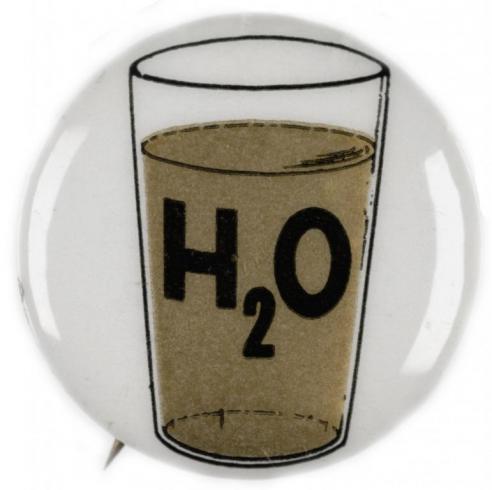 “wheeler-dealer.”
“wheeler-dealer.”
Voters, concerned over the nuclear war issue and possible loss of social security and other programs, gave an overwhelming victory to Lyndon Johnson (486 electoral votes to 52 for Goldwater). Johnson, who called the results a “mandate for unity,” received 61 percent of the popular vote. Virginia cast its 12 electoral votes for Lyndon Johnson.

